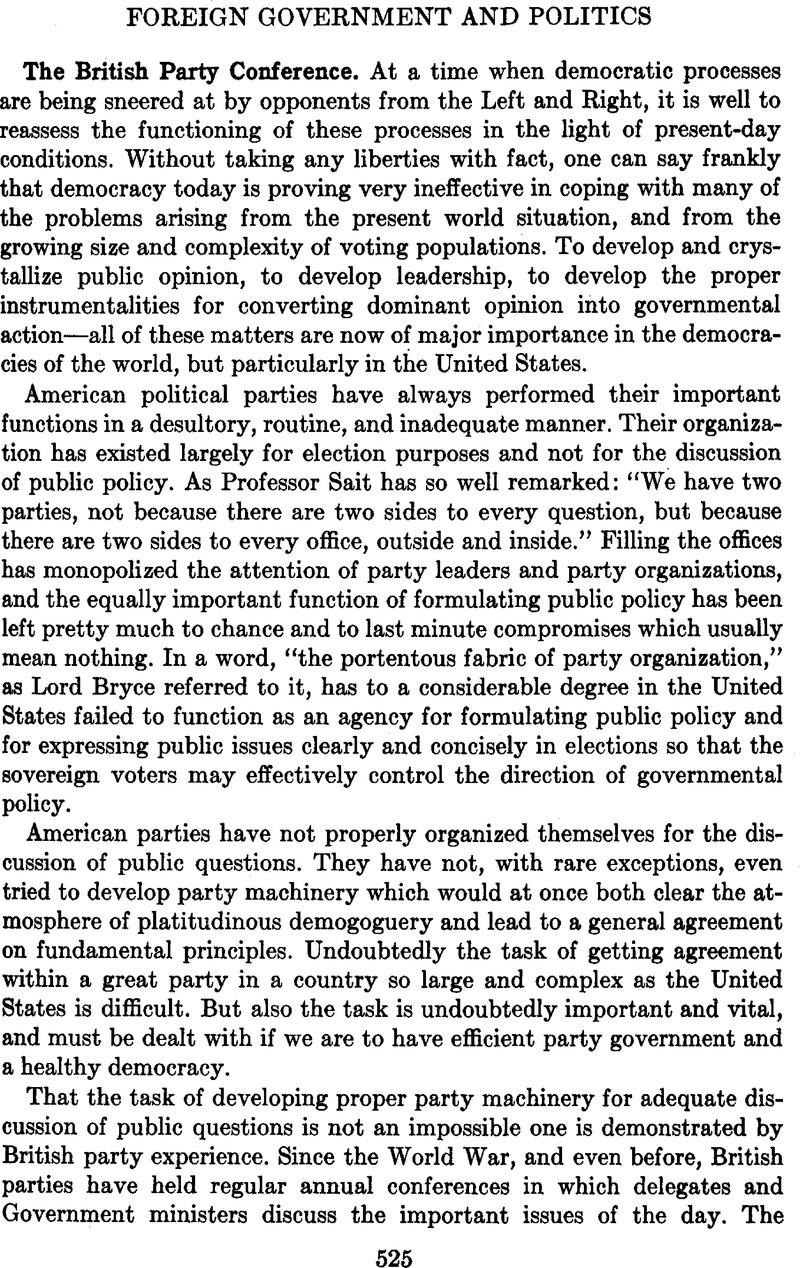No CrossRef data available.
Article contents
The British Party Conference
Published online by Cambridge University Press: 02 September 2013
Abstract

- Type
- Foreign Government and Politics
- Information
- Copyright
- Copyright © American Political Science Association 1938
References
1 See brief mention of this topic in Ogg, F. A., English Government and Politics (2nd ed., New York, 1936), pp. 581–587Google Scholar; Chase, E. P. and others, Democratic Governments in Europe (New York, 1935), pp. 105–107Google Scholar. See also the author's “British Party Organization”, in Political Science Quarterly, Vol. 45, pp. 161–181CrossRefGoogle Scholar.
2 The Constitution and Standing Orders of the Labour Party, as amended by the Annual Party Conference (Bournemouth, 1937)Google Scholar. The relevant clauses of the constitution are V, VI, VII, and VIII, and the standing orders, numbers 1, 2, 3, 4, 5, and 6.
3 Report, Annual Conference of the Labour Party, 1937, p. 280Google Scholar. This is the largest individual paid membership of any political party in the democratic world. In the dictatorship countries, party membership is larger.
4 The Constitution and Rules of the National Union of Conservative and Unionist Associations, Arts. XIV, XV, XVI, and XVII.
5 See The Times, December 17, 1936, for a report of a recent meeting of the Council.
6 At the meeting on March 24, 1937, for instance, the Central Council passed five resolutions on the following subjects: (1) reaffirming faith in conservative principles; (2) warm approval of the rearmament program; (3) full support of the Government's policy of voluntary army recruitment; (4) congratulating the Government on its traffic measures; and (5) urging that borough council elections be scheduled at a better time of the year and that the polling hours be extended. Two other resolutions dealing with ex-service men and milk regulations were withdrawn. The Times, March 24, 1937, p. 8dGoogle Scholar. See also Report of the Sixty-Third Annual Conference, 1936, pp. 30–35Google Scholar, and ibid., 1937, pp. 32-37, for reports of the Council and its Executive Committee.
7 In 1937, the Executive had 32 sessions. See Report, Annual Conference of the Labour Party, 1937, p. 72Google Scholar.
8 See the interesting studies by Professor Joseph R. Starr of Labor and Liberal activities of this nature in this Review, Vol. 30, pp. 956–974 (Oct., 1936), and Vol. 31, pp. 703–719 (Aug., 1937).
9 Report, Annual Conference of the Labour Party, 1933, pp. 8–11, 166–168Google Scholar.
10 Report of the Sixty-Third Annual Conference, 1936, p. 22Google Scholar. Also The Times, October 2, 1936, p. 8aGoogle Scholar.
11 The Times, October 3, 1936, p. 13bGoogle Scholar.
12 Report of the Sixty-Third Annual Conference, 1936, p. 30Google Scholar.
13 Ibid., 1937, p. 32.
14 The Times, October 3, 1936, p. 13bGoogle Scholar.
15 An interesting move was to create a Distressed Areas Commission composed of able party members. The commission first held representative delegate conferences in each of the areas to explain the scope of the work and to secure the coöperation of the local Labor movement. The second step was the preparation of written evidence by the local Labor movements. The third step consisted of visits and investigations in the areas by the commission. The fourth step was the preparation and publication of a series of very able reports. “Altogether this has proved to be,” in the words of the annual report of the party, “one of the most striking and successful projects undertaken by the party.” Report, Annual Conference of the Labour Party, 1937, pp. 18–20Google Scholar. See also Dr.Maddox', interesting article on “Advisory Policy Committees for British Parties”, in Political Science Quarterly, Vol. 49, p. 267Google Scholar.
16 This interesting program, in the words of Hugh Dalton, “is a deliberate study in priorities” which “represents a big constructive job of work.” The program has been issued in pamphlet form and may be found in the Report for 1937, Appendix X, pp. 277–279Google Scholar. It is a clear, concise program, for, as the chairman of the 1937 conference (Mr. Dalton) said, “we have no use at this time of day for rhetoric without research, nor platitudes without precision.”



Comments
No Comments have been published for this article.